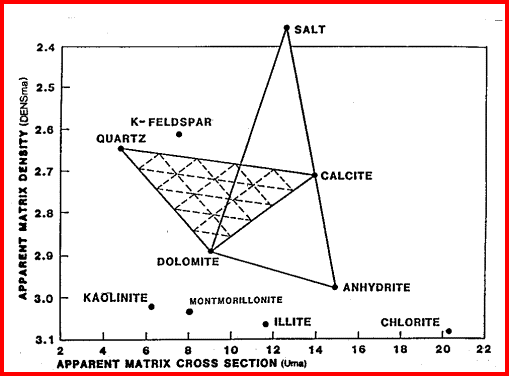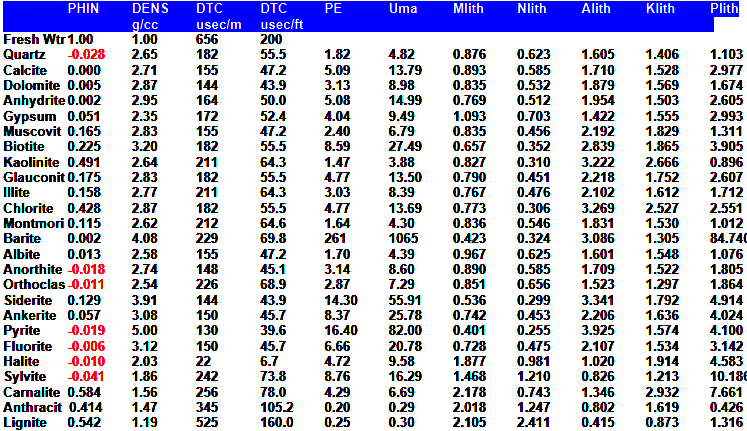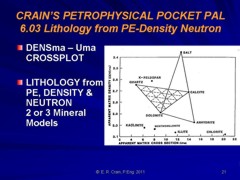Where:
PHIe = effective porosity (fractional)
U = photoelectric absorption cross section (barns/cm3)
UH = photoelectric absorption of hydrocarbon (barns/cm3)
UMA = photoelectric absorption of matrix rock (barns/cm3)
USH = photoelectric absorption of shale (barns/cm3)
UW = photoelectric absorption of water (barns/cm3)
Vsh = volume of shale (fractional)
Note - 1.0 barn = 1*10^- 24 square centimeters - pretty small cows!
 COMMENTS
COMMENTS
The Uma values can be used in crossplots with matrix density (DENSma), to determine lithology
fractions in a two or three mineral model.

Matrix Density vs Matrix Cross Section Crossplot
for Lithology
 Rock Volume from PE
Density Neutron Models
Rock Volume from PE
Density Neutron Models
A few preliminary calcs are
meeded:
3: DENS = PHID * KD1 + (1 - PHID) * KD2
4: DENSSH = PHIDSH * KD1 + (1 - PHIDSH) * KD2
5: DENSma = (DENS - PHIe * DENSW - Vsh * DENSSH) / (1 - PHIe
- Vsh)
6: USH = PESH * DENSSH
7: Uma = (PE * DENS - Vsh * USH) / (1 - PHIe - Vsh)
 PE 2- Mineral Model
PE 2- Mineral Model
Linearly interpolate between any two mineral
end points and solve for Vmin1 and Vmin2. This is the ONLY
mineral model for gas zones as PE is unaffected by gas.
Also excellent for oil and water zones.
8: Vmin1 = (PE - PE2 - Vsh * PESH)
/ (PE1 - PE2)
9: Vmin2 = 1.00 - Vmin1
` Uma 2- Mineral Model
Uma 2- Mineral Model
Linearly interpolate between any two mineral
end points and solve for Vmin1 and Vmin2. DO NOT usel for gas
zones.
10: Vmin1 = (Uma - UMA2 - Vsh *
USH) / (UMA1 - UMA2)
11: Vmin2 = 1.00 - Vmin1
` DENSma 2- Mineral Model
DENSma 2- Mineral Model
Linearly interpolate between any two mineral
end points and solve for Vmin1 and Vmin2. DO NOT usel for gas
zones.
12: Vmin1 = (DENSma - DENS2) / (DENS1 - DENS2)
13: Vmin2 = 1 - Vmin1
 DENSma - Uma 3 - Mineral Model
DENSma - Uma 3 - Mineral Model
Crossplot solution to three mineral end points
DO NOT usel for gas zones.
See
Density Log Models
for DENSma calculation, needed for this model.
14: D = (Uma * (DENS2 - DENS1) + DENSma * (UMA1 - UMA2)
+ UMA2 * DENS1 - UMA1 * DENS2) / (UMA1 * (DENS3 - DENS2)
+ UMA2 * (DENS1 - DENS3) + UMA3 * (DENS2-DENS1))
15: E = (D * (DENS3 - DENS1) - DENSma + DENS1) / (DENS1 - DENS2)
16: Vmin1 = MAX(0, 1 - D - E) /
(MAX(0, 1 - D - E) + MAX(0, D) + MAX(0, E))
17: Vmin2 = MAX(0, E) / (MAX(0, 1
- D - E) + MAX(0, D) + MAX(0, E))
18:Vmin3 = (1 - Vmin1 - Vmin2)
Where:
PHIe = effective porosity from any method (fractional)
PE = measured PE log value of rock mixture
PE1 = PE of first mineral (fractional)
PE2 = PE of second mineral (fractional)
Vmn1 = relative volume of first mineral (fractional)
Vmin2 = relative volume of second mineral (fractional)
Vmin3 = relative volume of third mineral (fractional)
Vsh = volume of shale (fractional)
Uma = computed UMA value of rock mixture
UMA1 = UMA of first mineral (fractional)
UMA2 = UMA of second mineral (fractional)
UMA3 = UMA of third mineral (fractional)
DENSma = computed matrix density value of rock mixture
DENS1 = matrix density of first mineral (fractional)
DENS2 = matrix density of second mineral (fractional)
DENS3 = matrix density of third mineral (fractional)
 COMMENTS:
COMMENTS:
The relative Vmin values must be multiplied by
Vrock to get absolute values of V1, V2, V3. Vrock = 1- PHIe -Vsh..
 NUMERICAL
EXAMPLE:
NUMERICAL
EXAMPLE:
1.
Assume data as follows:
PE = 1.68 barns/cm3
DENS = 2.20 gm/cc
PHIN = 0.27
U = 1.68 * 2.20 = 3.69
Uma = 1.68 * 2.20 / (1 - 0.27) = 5.20
Both
PE and Uma are close to the quartz values. If
it is dolomitic sandstone, assume:
Vsh = 0.10
PHIe = 0.24
Uqrtz = 4.79
Udolo = 9.00
Vmin1 = (5.20 - 9.00) / (4.79 - 9.00) = 0.90
Vmin2 = 1.00 - 0.90 = 0.10Vrock
= 1 - 0.10 - 0.24 = 0.66.
Values to plot in lithology track:
V1 = 0.90 * 0.66 = 0.60
V2 = 0.10 * 0.66 = 0.06
The
rock matrix is 90% quartz, 10% dolomite, but 34% of this is made
up of porosity and shale, so the actual volumes of matrix rock
are reduced by this amount.
 MATRIX
ROCK PARAMETERS
MATRIX
ROCK PARAMETERS







